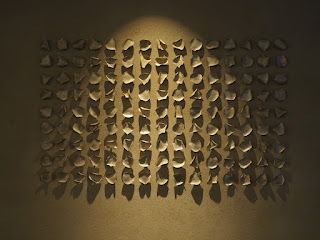隊列を組み飛んでいく渡り鳥の群れ。
あるタイミングで一斉に方向を変化させる魚群。
隙間なく並ぶ植物の種子や意思を持っているかのように延びる蔓。
ありふれた風景の一部として眺める自然現象がときに、まるでなにかの自動運転によって
動かされているかのように感じてハッと我に返るかのように驚かされることがあります。
そしてまたあらためてじっくりと観察していくと、自分の中に対象物の感覚が入り込み
そのイメージと自身の境界があいまいになるような錯覚をも覚えるのです。
「自然をふつうに見ますと単に自然が見えるだけです。しかし、仔細に見ますといちいち
いかにもふしぎなのです。(中略) このようなものを人はつくることもできなければ、
説明することもできません。わたしたちは、このつくれそうもないことわかりそうも
ないことに目 をふさいでいるがゆえに、すべて知っているように思いますが、仔細に
見ると自然はこのようなふしぎにみちているのです。このふしぎまで見ることのできる
人が自然を見ますと、単に自然を見ているだけではなく自然あらしめているものも同時
に見ているのだといえます。」 (「 風蘭」1964年 ― いのち ―/岡潔 )
数学者の岡潔氏が記述したこの一節は、一連のインスタレーション作品において自分が
何を掴もうとしたのかを気づかせてくれることばでもあります。さまざまな様相の磁土
ピースを整列させてみたときに出現する景色は、一見無秩序な自然物をじっと観察して
いたとき、ある瞬間、その奥行きの先にある世界の大きな存在を垣間見たような自らの
体験を重ねようとしていたものであるのだと振り返ります。また対象物の観察を通じて
得られる体験は、自分もまた氏の言う「自然あらしめているもの」一部であり、それ
によって成されているのだと気づくことでもあります。
「まことに人とはふしぎなものです。(中略)わたしたちは、それを意識していないの
ですが、きわめて具体的に情緒(意志的情緒)を物質(肉体)にする。つまり、物質によっ
て四次元的に表現する力をもっています。」 (「 風蘭」1964年 ― いのち ―/岡潔 )
岡潔は、ふだん私たちが何気なく行う動作においても、その意志と肉体の動作が自然
と通じ合うふしぎさについて同著で触れています。自分もまた自然的存在でもあると
いう感覚に身を置くこと、自分の体感が世界のありようと重なっていくような感覚を
写すことがこれらのインスタレーション作品に共通し意図するところです。
そしてまた制作においても、用いる対象素材を丹念に観察し自分の動機と密に関わって
いくことで、自分の感覚と物質が互いに絡まり合う体験があります。そうして生み出さ
れる造形物 は、人が世界で生きていくためのものづくりの原型の姿とも映り、悠久の
時空を想像する感覚や 自分自身のなかに脈々と流れるヒトが受け継いできた何かを
実感することでもあるのです。
Flocks of migrating birds flying in a “V”.
A school of fish that changes direction in unison.
Seeds arranged neatly in berries, and vines that extend as if t hey have a will of their own.
Natural phenomena that I see as part of the ordinary scenery so metimes startle me back to my senses as if they are being driven by some external force. And when I look at it again carefully, I feel as if t he sensation of t hat force has entered my mind and the boundary between the image and myself has become blurred.
“When we look at nature in an ordinary way, we simply see nature. But when we look at it in detail, it is very mysterious. (omission) We cannot create such things, nor can we explain them. We think we know everything because we don’ t look carefully at the things we cannot create or understand, but when we look closely, we find that nat ure is full of such mysteries. When a person who can see these mysteries looks at nature, he or she is not only looking at nature, but is also looking at what makes nature what it is.” (“Fūran”1964. ‒Inochi‒/Kiyoshi Oka)
This passage, described by mathematician Kiyoshi Oka, reminds me what I was trying to figure out in my series of installation works.I understand th at the views that emerge when I arrange the various shapes of the porcelain piece s are an attempt to superimpose my own experience, as if at a certain moment when I was observing a seemingly random natural object, I caught a glimpse of the world beyond the depth of the object. My experience gained from observing the object is the realization that I am also generated by what he calls “what makes nature what it is”.
"We are indeed a mysterious thing, he said. (omission) We are not conscious of it, but We very concretely make emotion (willful emotion) into matter (body). In other words, we have the power to express ourselves in four dimensions through matter."(“Fūran”1964. ‒Inochi‒/Kiyoshi Oka)
In the same book, Kiyoshi Oka describes the mysteriousness of t he natural connection between our emotion and our physical actions, in the actions we perform without thinking about them. The common theme of these installation work s is to place myself in the feeling that we are also a natural being, and to feel the sensation that my own physical experience overlaps with the state of the wo rld. In the process of creation, I observe the materials carefully, there is an experience of my s enses and matter intertwining with each other, becoming intimately involved with my motives. The objects created i n this way can b e seen as the p rototypes of th e w ay p eople make things in order to live in the world, and they are a way of ima gining a timeless space and time, and of realizing something that has been passed down from generation to generation in the human body.

.jpg)







.jpg)
.jpg)

















